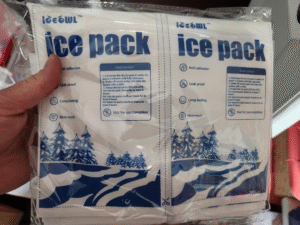Traveling with dry ice in 2025 requires a thoughtful approach, as dry ice (karbon dioksida padat) poses unique risks during transport. Whether you’re shipping perishables or scientific supplies, packing dry ice safely is crucial to avoid accidents and comply with strict regulations. Dalam panduan ini, we’ll walk you through the essential safety precautions, packaging tips, and the latest rules to ensure a smooth journey when traveling with dry ice.
-
What are the latest safety regulations for dry ice transport?
-
How can I pack dry ice to prevent accidents and ensure compliance?
-
What are the best materials and containers for dry ice during air travel?
What Are the Safety Regulations for Dry Ice in 2025 Air Travel?
Dry ice is regulated due to the potential hazards it presents. It sublimates into carbon dioxide gas, which can displace oxygen in confined spaces, creating a suffocation risk. The Federal Aviation Administration (FAA) and the International Air Transport Association (Iata) have stringent guidelines to prevent such incidents.
Key Regulations Include:
-
Weight Limits: Most airlines allow up to 5.5 pound (2.5 kg) of dry ice per passenger on domestic flights. Namun, international flights may have stricter rules, so check with your airline in advance.
-
Pelabelan: Containers with dry ice must be clearly labeled with “DRY ICE” atau “CARBON DIOXIDE SOLID” and show the exact weight of the dry ice.
-
Ventilation: Containers must allow the release of carbon dioxide gas to avoid pressure buildup, which could cause dangerous leaks or explosions.
Untuk tipnya: Always inform the airline in advance if you’re traveling with dry ice, especially if the amount exceeds the limit.
Packing Dry Ice Safely for Air Travel
Proper packing is the first step toward safe dry ice transport. To ensure your dry ice remains effective throughout the journey, use the right materials and follow best practices for insulation and ventilation.
Key Packing Guidelines:
-
Choose Insulated Containers:
Use Styrofoam coolers or specially designed dry ice containers to slow the sublimation rate and protect the contents. These materials help maintain a low temperature while preventing the rapid gas buildup. -
Ensure Proper Ventilation:
Dry ice sublimates into gas, so never seal the container tightly. Always ensure the container has ventilation holes or a loosely fitting lid to allow the gas to escape safely. -
Correct Labeling:
Clearly mark your dry ice container dengan “DRY ICE” and indicate the net weight of the dry ice. This labeling is required by the FAA and IATA for safety and regulatory compliance. -
Avoid Overpacking:
While it may seem like packing more dry ice will ensure cooler temperatures, overpacking can violate airline regulations and lead to excessive gas release. Pack only as much dry ice as necessary based on the travel time.
How to Prevent Dry Ice from Sublimating Too Quickly
Dry ice sublimates at a rate of 5-10 pounds per 24 jam, depending on the size of the dry ice, the container, and external temperatures. To prevent rapid sublimation:
-
Layer insulation: Use multiple layers of insulating material to slow down sublimation.
-
Avoid heat sources: Keep the dry ice away from any heat sources (like aircraft engines) to prolong its effectiveness.
What Are the Best Packaging Materials for Dry Ice?
Choosing the right material for your dry ice container is critical. Here are some packaging options and their benefits:
| Packaging Type | Pros | Cons | Best Use Case |
|---|---|---|---|
| Styrofoam Box | Ringan, Insulating | Not waterproof | Short-term transport |
| Insulated Cooler | Isolasi yang sangat baik | Bulkier, more expensive | Extended travel or shipping |
| Plastic Container | Tahan lama, Affordable | Less effective insulation | Small shipments |
What if I Need to Ship More Than 5.5 Pounds of Dry Ice?
For shipments exceeding the 5.5-pound limit, it’s essential to follow additional regulations:
-
Notify the Airline: Inform your airline ahead of time to get approval for transporting larger quantities.
-
Complete Safety Data Sheets (SDS): Provide SDS documentation to inform handlers of any potential hazards associated with dry ice.
How to Handle Dry Ice Safely During Air Travel?
Handling dry ice requires protective measures to avoid frostbite or injury due to its extremely cold temperature (-109.3° f / -78.5° C.).
Safety Precautions for Handling Dry Ice:
-
Wear Protective Gloves: Always use insulated gloves when handling dry ice to prevent frostbite.
-
Avoid Direct Contact: Never touch dry ice with bare hands. Use tools like tongs to handle it.
-
Ventilated Storage: Ensure that dry ice is stored in a well-ventilated space, as the sublimating gas can accumulate quickly in confined areas.
Real-Life Example: A pharmaceutical company shipping medical samples used insulated coolers with vents to ensure dry ice lasted throughout a 24-hour journey. By complying with safety regulations and using appropriate packaging, they successfully transported sensitive materials without incident.
How Do Airline Restrictions on Dry Ice Affect Travel?
Airlines impose specific restrictions to protect the safety of passengers and crew. These regulations are designed to prevent accidents caused by excessive carbon dioxide buildup. Here’s why these rules matter:
-
Oxygen Displacement: Dry ice sublimates into carbon dioxide, which can displace oxygen in confined spaces like aircraft cargo holds.
-
Pressure Buildup: Tight-sealing containers can cause dangerous pressure buildup as gas is trapped inside.
What Are the Latest Trends in Dry Ice Transportation (2025)?
Di dalam 2025, advancements in dry ice transport continue to evolve:
-
More Stricter Regulations: With the increasing global demand for cold chain logistics, new, stricter regulations are being enforced to ensure safe transport of perishable goods.
-
Innovative Packaging Materials: Sustainable and reusable containers are being developed to make dry ice transportation more eco-friendly.
-
Safety Enhancements: New technologies in automated ventilation systems are improving safety by ensuring gas release in dry ice containers.
Common Questions About Dry Ice in Air Travel
Q1: Can I bring dry ice on a plane?
Ya, you can bring dry ice, but it must be in an approved, vented container and within the weight limits (biasanya 5.5 pounds or 2.5 kg). Always check with your airline in advance.
Q2: How do I calculate how much dry ice I need?
For every 24 hours of travel, pack 2.5 pound of dry ice per person. Adjust based on the journey’s duration, the insulation quality, and the type of items being transported.
Kesimpulan
Packing dry ice for air travel requires attention to safety, kepatuhan, and proper handling. By following the necessary guidelines and using the right containers, you can ensure safe and efficient transport. Always stay informed of the latest regulations to avoid potential issues during your trip.
Langkah selanjutnya: Before your next journey with dry ice, consult with your airline for specific regulations and ensure your packaging meets safety standards. This will help you avoid delays and ensure the successful transport of your sensitive items.
Tentang tempk
Tempk provides reliable cold chain solutions for air and sea transport, specializing in high-quality, safe packaging for dry ice and other sensitive materials. Let us help you safely transport your perishable goods.
Call to Action: Contact Tempk for expert advice on packing and shipping dry ice safely.
























